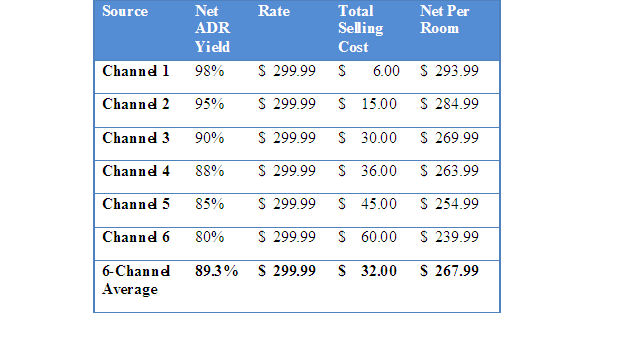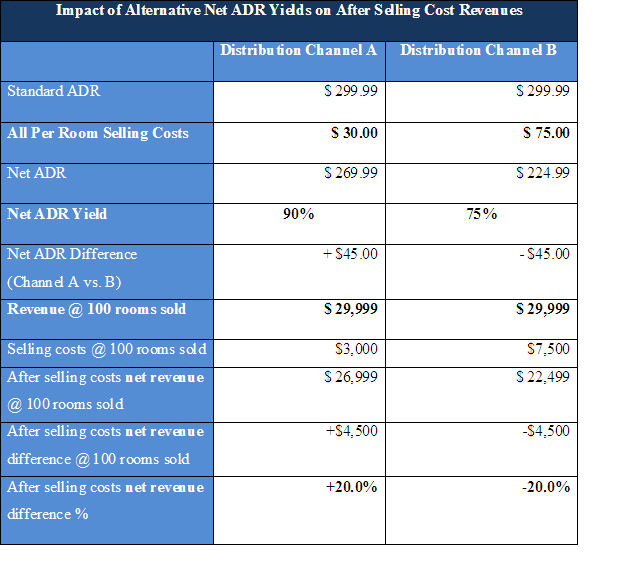
advertisement
A New Tool For The Thoughtful Revenue Manager's
Channel Evaluation Tool Box
|
News for the Hospitality Executive |

advertisement
|
By
Dr. David Hayes and Allisha Miller
Abraham Maslow observed that “When your only tool is a hammer, you tend to see every problem as a nail.” Maslow wasn’t a hotel revenue manager but his reflection on problem solving is a nice warning to all managers, and especially revenue managers, that they must be careful not to automatically seek to apply old solutions to new problems. The same thought was put somewhat differently by General George Patton when he observed; “If everyone is thinking alike, someone isn’t thinking.” For hotel revenue managers, these two warnings are especially important to remember when dealing with the problem of assessing distribution channel-related costs. Today’s revenue manager needs answers to critical questions such as:
The
higher the total revenue generated by a distribution channel (evaluated
by
assessing
Rooms Sold x ADR); the better the channel.
As the highly publicized conflict
between airlines and on-line
travel sites (such as American Airlines and Expedia) continues to
suggest, in
the rapidly changing selling environment encountered today, we would
suggest the
hotel revenue manager’s new problems are not standard nails and the
solution is
not the standard hammer.
To begin at the beginning, it is important to recognize that room buyers utilize a variety of different distribution channels because that allows guests the ability to buy the products they want when, and how, they want to buy them. Thus, the various external channels used by hoteliers to help them sell rooms add value to the products and services buyers purchase. Of course, all of those distribution channel operators (including the oft-maligned web-based intermediaries) must charge for their services if they are to stay in business. To make their profits, intermediaries have two choices. They can charge buyers for their services or they can charge sellers. In the hotel industry, they charge the sellers. That’s your hotel. As a seller, the costs you incur when selling in different channels can vary dramatically. Savvy revenue managers recognize that these costs can and must be managed. The careful selection of the distribution channels to be utilized is one way of managing these costs. Another way to manage them is the implementation of policies and procedures designed to move repeat buyers from higher-cost channels of distribution to lower cost channels. The problem, of course, is how to know which channels have the lowest cost so buyers can be moved to more cost effective channels. That’s a problem that cannot be solved using the revenue generation hammer because revenue maximization does not address distribution channel cost differences. Neither can these costs be addressed solely by an assessment of ADR. Yet today’s revenue managers know something truly critical and deceptively simple. They know: All
revenue
dollars are not created equally.
While that statement is true, the problem of determining where the best revenue dollars come from requires a new tool. To see why, consider the following table that shows the percentage of charged ADR (let’s call that the channel’s Net ADR Yield) that remains after all of the distribution (selling) costs associated with the use of a channel have been subtracted. That’s also the amount of the room’s price the hotel actually gets to keep. These costs typically include those assessed by the channel itself, the GDS, all selling commissions, franchise fees and any other selling-related charges incurred by the hotel’s use of the channel. In this example the $299.99 room rate charged to guests is the same across all channels. The channel-specific costs incurred by the hotel in the sale of the rooms, the Net ADR Yield and thus the money actually received by the hotel, however, vary a good bit. Note that these channels’ actual revenue contributions range from a high of 98% of rate to a low of 80% of charged rate. The un-weighted Net ADR Yield averages 89.3% across all channels.  A chart like
this one is a handy tool because in most cases, the number of rooms
sold in
each channel will not be equal. Thus it is both the amount of revenue
received
AND the amount (percentage) the hotel is allowed to keep that is of
most
importance to revenue mangers.
Fortunately the computation of a channel’s Net ADR Yield is easy. Net ADR Yield is computed as:  *Note: In this formula;
Standard ADR minus All
Distribution Channel-Related Selling Costs = Net Room Rate To illustrate, when
an intermediary collects $299.99 for a guest’s room (the standard room
rate) and
subsequently the hotel receives $269.99 from the intermediary (i.e.
$30.00 less
than the standard rate charged to the guest), the Net ADR Yield formula
for
that channel would be:
 Net ADR Yield is a good tool to
have in your revenue manager's tool box because a good tool should help
you address and solve problems. Net ADR Yield does just that.
To use the tool properly, it is important to understand that a higher Net ADR Yield channel (like Channel 1 in the chart above) will yield top-line revenues that are more profitable than rooms sold at the same rate on a channel with a significantly lower Net ADR yield (like those from Channel 6). This is so because Channel 1 yields more net revenue per sale (and you now know why the authors like to call the tool Net ADR Yield!) The most important number for revenue managers to assess is the overall Net ADR Yield (89.3% in this simplified example). When revenue managers understand the use of the NET ADR Yield tool they can use it to address key questions such as:
Differences in a channel’s Net ADR Yield are important. To see why, consider the two distribution channels below. Each sold 100 rooms for you and the ADR for the rooms sold was identical.  Notice that in this
example a 15% variance in Net ADR Yield results in a 20% difference
($26,999-$22,499)/
$22,499 = 20%) in after selling costs
revenue.
Note too, that this difference occurred despite the fact that revenue
collected
and rooms sold in both channels was identical. These revenue and
selling cost-related
differences are of the exact type that customer-centric revenue
managers and
their sales colleagues must understand because, for obvious reasons,
they are very
well-known to hotel owners and GMs.
It has been a truism in the lodging industry that good distribution channels produce room sales for a hotel. The new reality, however, is that the best channels deliver high Net ADR Yields. And the best revenue managers monitor those yields. If the value of knowing your hotel's individual channel and overall Net ADR Yield is now apparent to you, then you are really getting the hang of using this tool. Of course, it is still important for RMs to know the ADRs achieved by their properties because that number, when multiplied by rooms sold does yield total revenue. It is even more important, however, that today's revenue managers know the Net ADR Yields produced by each of their significant distribution channels and that they work actively to continually increase those yields by:
What is also clear is that the shift in thinking needed to thrive in today’s competitive pricing environment is away from RevPAR maximization only; and toward a serious consideration of room sales profitability. It’s a new way to think, and it requires new tools for problem solving. With Net ADR Yield in your tool box you have one of those new tools! About this Article: This article is based on information in Revenue Management for the Hospitality Industry by David K. Hayes and Allisha A. Miller. © 2011 John Wiley & Sons, Inc. All rights reserved. To purchase this book or obtain information about bulk sales, please contact [email protected] About the Authors: Dr. David K. Hayes and Allisha A. Miller manage Panda Professionals (www.pandapros.com) Hospitality Education and Training where they create and deliver innovative and practical educational materials and training for those in the hospitality industry. |
| For
More Information Contact: Allisha Miller Panda Professionals 1715 E Jolly Road Okemos, MI 48864 [email protected] |
| Also See: |
What
Is A Fair Price? - And Who Gets to Decide? What Customer-centric
Lodging Revenue Managers Need To Know / Dr. David Hayes &
Allisha Miller / November 2010 |